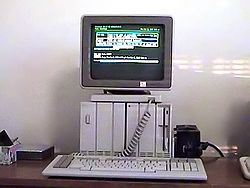CTOS
The Convergent Technologies Operating System , also known by the names CTOS , BTOS and STARSYS , was a modular, multi-process-based operating system from Convergent Technologies .
Convergent Technologies' first product was the IWS ( Integrated Workstation ), which was based on the Intel 8086 processor and implemented CTOS as the operating system. The successor product NGEN was later licensed and distributed by Bosch ( Telenorma ).
properties
The CTOS operating system based on a 4K real-time - microkernel , these included
- multitasking
- Network connection
- Multiple processes and threads
- Message-based interprocess communication
The kernel interpreted the message and forwards the message to the resource that could reply to the message. It did not matter whether the response came from the local system or a remote system. Each CTOS - Workstation managed a resource table. When a message was received, the microkernel checked whether a local resource existed for this message; if not, the kernel tried to delegate the message via the network to a CTOS instance acting as a server .
This system enabled network systems based on the 8086 (RS422 / 307K baud) to be set up as early as 1986 , which made it possible to work together on databases (Datamanager), multiplan tables or texts within a "cluster" of a maximum of 16 workstations.
It was interesting that this system was initially delivered with the complete source code and that the user had a complete “Office” package consisting of a data manager, Multiplan and word processing. In addition to Assembler, Basic and Pascal, Fortran and Cobol compilers were also available. ISAM and SAM file formats as well as a font designer as well as 3270 , RJE and AT emulators were available as with mainframes. The system was able to communicate with both TCP / IP networks and SNA networks via a network module. If necessary, the user's instinct to play was also met and a rat-catching game for the text matrix systems and a helicopter simulation game for the graphics systems were delivered when horizontally jumping tennis balls or horizontally flying saucers were hit by keyboard clicks on the other systems were.
hardware
The hardware of the systems initially consisted of 8 ″, later 5.25 ″ floppy disks and 5 MB to 20 MB hard disks (Burroughs B20 / 8086 5 MHz 256–640 KB RAM). A modular hardware system (NGEN) was later developed, the hardware components of which were to be assembled in a row with simple lever-clamp connections. By a bus system connected to each other, the desired workstation system processor could ( Intel 8088 , 80286 / 80386 ... 5 MHz 128 KB to 512 KB RAM), mono graphics unit (15 "× 9 11Pix / 28 × 80Zeilen) or color graphics systems with mouse, hard disk (5–100 MB), tape unit, floppy, ISDN box and even a hardware PC emulator (80286), whereby the individual components could be exchanged and combined. This system structure was far ahead of its time, but could not prevail against the cheaper and technically simpler competition from Apple , Commodore , Amiga and PC. Depending on the distributor , the operating system was operated like a UNIX system; with Bull systems, operation was extremely simple and could be operated purely using top-level commands. In addition, Bull had various office communication programs on offer, word processing, spreadsheets and extended connection options to mainframes from Bull and IBM were possible via both X.25 and TCP / IP .
distribution
Companies that licensed CTOS were Burroughs ( BTOS ) and Bull Computer ( STARSYS ). The largest licensee was Unisys . In Germany, the hardware was offered by Burroughs (B20 / B21 / B22), TELENORMA / Bosch ( NGEN / TNOS ), MDS Hero (Mohawk Data Sciences) and Bull Computer (Questar 400 series / Q400 / Q410 / Q420 / Q460) . Convergent Technologies and Unisys merged in 1988 . In 1996 , CTOS was discontinued.
